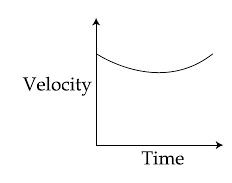Which graph corresponds to an object moving with a constant negative acceleration and a positive velocity ?
The Correct Option is C
Solution and Explanation
\(a = -C\)
\(\frac{VdV}{dx} = -C\)
\(VdV = - CdX\)
\(\frac{V^{2}}{2} = -Cx + k\)
\(x = -\frac{V^{2}}{2C}+\frac{K}{C}\)
\(\text{The Correct Option is (C): }\)
Top Questions on Motion in a straight line
- A ball is dropped from a height of 20 m. What is its velocity just before hitting the ground? (Take \( g = 9.8 \, \text{m/s}^2 \))
- VITEEE - 2025
- Physics
- Motion in a straight line
- A body is thrown vertically upwards with an initial velocity of \( 10 \, \text{m/s} \). How high will the body rise? (Take \( g = 10 \, \text{m/s}^2 \))
- VITEEE - 2025
- Physics
- Motion in a straight line
- A body is falling freely under gravity from a certain height from the ground. If the sum of the displacements of the body in the second and third seconds of its motion is 32% of the height from which it is falling, then the speed with which the body hits the ground is (Acceleration due to gravity = $10~\text{m s}^{-2}$)
- TS EAMCET - 2025
- Physics
- Motion in a straight line
- A motor cyclist is travelling towards north with a uniform speed of 10 ms\textsuperscript{−1} and a train is travelling towards north-west with a uniform speed of 102 ms\textsuperscript{−1}. The direction of motion of the motor cyclist as observed by a passenger in the train is
- TS EAMCET - 2025
- Physics
- Motion in a straight line
- A car accelerates uniformly from rest to a velocity of \( 25 \, \text{m/s} \) in \( 10 \, \text{seconds} \). What is the acceleration of the car?
- MHT CET - 2025
- Physics
- Motion in a straight line
Questions Asked in JEE Main exam
Nature of compounds TeO₂ and TeH₂ is___________ and ______________respectively.
- JEE Main - 2025
- Inorganic chemistry
- Let \( A = [a_{ij}] \) be a matrix of order 3 \(\times\) 3, with \(a_{ij} = (\sqrt{2})^{i+j}\). If the sum of all the elements in the third row of \( A^2 \) is \( \alpha + \beta\sqrt{2} \), where \(\alpha, \beta \in \mathbb{Z}\), then \(\alpha + \beta\) is equal to:
- JEE Main - 2025
- Matrices and Determinants
Consider the following sequence of reactions :

Molar mass of the product formed (A) is ______ g mol\(^{-1}\).- JEE Main - 2025
- Organic Chemistry
The magnitude of heat exchanged by a system for the given cyclic process ABC (as shown in the figure) is (in SI units):

- JEE Main - 2025
- Electric charges and fields
- The value of \( (\sin 70^\circ)(\cot 10^\circ \cot 70^\circ - 1) \) is:
- JEE Main - 2025
- Trigonometric Identities
Concepts Used:
Motion in a straight line
The motion in a straight line is an object changes its position with respect to its surroundings with time, then it is called in motion. It is a change in the position of an object over time. It is nothing but linear motion.
Types of Linear Motion:
Linear motion is also known as the Rectilinear Motion which are of two types:
- Uniform linear motion with constant velocity or zero acceleration: If a body travels in a straight line by covering an equal amount of distance in an equal interval of time then it is said to have uniform motion.
- Non-Uniform linear motion with variable velocity or non-zero acceleration: Not like the uniform acceleration, the body is said to have a non-uniform motion when the velocity of a body changes by unequal amounts in equal intervals of time. The rate of change of its velocity changes at different points of time during its movement.


